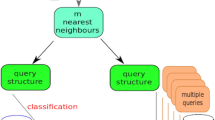Abstract
Neural network ensemble is a powerful tool for simulating the quantitative structure activity relationship in drug discovery because of its high generalization ability. However, the architecture of the ensemble and the training parameters of individual neural networks are closely relative to the generalization performance of the ensemble and the convenience of the creation of the ensemble. This paper proposes a novel creation algorithm for neural network ensemble, which employs uniform design to guide users to design the ensemble architecture and adjust the training parameters of individual neural networks. In addition, this algorithm is applied to produce neural network ensemble for predicting activities of drug molecules, which is a convenient way to achieve better results than commonly used bagging methods.
Preview
Unable to display preview. Download preview PDF.
Similar content being viewed by others
References
Xu, L., Wu, Y., Hu, C., Li, H.: A QSAR of the Toxicity of Amino-benzenes and Their Structures. Science in China (Series B) 43(2), 130–136 (2000)
Chen, N.Y., Lu, W.C., Yang, J., Li, G.Z.: Support Vector Machine in Chemistry. World Scientific Publishing Co. Pt. Ltd., Singapore (2004)
Sollich, P., Krogh, A.: Learning with Ensembles: How Over-fitting Can Be Useful. Advances in Neural Information Processing Systems, 190–196 (1996)
Slam, M.M., Yao, X., Murase, K.: A Constructive Algorithm for Training Cooperative Neural Network Ensembles. IEEE Trans. on Neural Networks 14(4), 820–834 (2003)
Liu, Y., Li, Y., Li, G.Z., Zhang, B.F., Wu, G.F.: Constructive Ensemble of RBF Neural Networks and Its Application to Earthquake Prediction. In: Wang, J., Liao, X.-F., Yi, Z. (eds.) ISNN 2005. LNCS, vol. 3496, pp. 532–537. Springer, Heidelberg (2005)
Akhand, M.A.H., Murase, K.: A Minimal Neural Network Ensemble Construction Method: a Constructive Approach. Advanced Computational Intelligence and Intelligent Informatics 11(6), 582–592 (2007)
Zhou, Z.H., Wu, J., Tang, W.: Ensembling Neural Networks: Many Could Be Better Than All. Artificial Intelligence 137(1-2), 239–263 (2002)
Li, G.Z., Yang, J., Kong, A.S.: Neural Network Ensemble Based on Clustering Algorithm. Journal of Fudan University 5, 689–691 (2004) (in Chinese)
Fang, K.T.: Uniform Design and the Uniform Design Table. Science Press, Beijing (1994) (in Chinese)
Li, G.Z., Meng, H.H., Lu, W.C., Yang, J.Y., Yang, M.Q.: Asymmetric Bagging and Feature Selection for Activities Prediction of Drug Molecules. BMC Bioinformatics 9 (Suppl. 6), S7 (2008)
Author information
Authors and Affiliations
Editor information
Editors and Affiliations
Rights and permissions
Copyright information
© 2008 Springer-Verlag Berlin Heidelberg
About this paper
Cite this paper
Liu, Y., Yin, Y., Teng, Z., Wu, Q., Li, G. (2008). Activities Prediction of Drug Molecules by Using the Optimal Ensemble Based on Uniform Design. In: Huang, DS., Wunsch, D.C., Levine, D.S., Jo, KH. (eds) Advanced Intelligent Computing Theories and Applications. With Aspects of Theoretical and Methodological Issues. ICIC 2008. Lecture Notes in Computer Science, vol 5226. Springer, Berlin, Heidelberg. https://doi.org/10.1007/978-3-540-87442-3_15
Download citation
DOI: https://doi.org/10.1007/978-3-540-87442-3_15
Publisher Name: Springer, Berlin, Heidelberg
Print ISBN: 978-3-540-87440-9
Online ISBN: 978-3-540-87442-3
eBook Packages: Computer ScienceComputer Science (R0)




